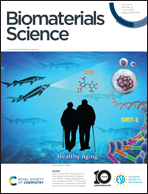Albumin-based near-infrared phototheranostics for frequency upconversion luminescence/photoacoustic dual-modal imaging-guided photothermal therapy†
Abstract
Engineering versatile phototheranostics for multimodal diagnostic imaging and effective therapy has great potential in cancer treatment. However, developing an inherently versatile molecule is a huge challenge. In this work, a near-infrared organic dye (NRh) was synthesized and further bound with bovine serum albumin (BSA) to construct facile “one-for-all” phototheranostics (NRh-BSA NPs), which exhibited enhanced frequency upconversion luminescence (FUCL, λex/em = 850/825 nm) and excellent photoacoustic (PA) and photothermal properties (λ′ex = 808 nm). Additionally, the BSA-modified phototheranostics NRh-BSA NPs showed specific accumulation in the tumor region through passive targeting. Based on the FUCL/PA dual modal imaging-guidance, the NRh-BSA NPs not only can guarantee the accuracy of imaging of the U87MG tumor sites, but also can improve the therapeutic effect on ablating tumors without recurrence by photothermal therapy (PTT). Collectively, our work proposed a novel strategy to construct versatile phototheranostics with the unique FUCL/PA imaging-guided technique for accurate cancer theranostics.



 Please wait while we load your content...
Please wait while we load your content...